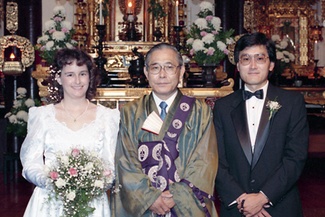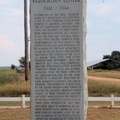I’m not yet at the age where I scan the obituaries for people I knew, like I remember my father doing. In his later years, he would open the paper to the obituaries most days, looking for the names of acquaintances. I remember my father saying: “I was talking to Don the other day. Frank is gone. Don and I are the only ones left from camp now.” (Don and my father were roommates for a time in the Jerome War Relocation Authority incarceration camp in Arkansas during WWII.)
But one August evening a few years ago, on the kitchen table was the day’s newspaper, open to the obituary section. I saw a familiar face and name—Reverend Hiroshi Futaba, who performed the wedding for my wife, Catherine, and me over twenty years ago. His funeral was two days away.
Later that night, I sat down with a sympathy card and wondered what I should write to the family. Should it just be the standard “condolences on your loss” or should I write something more personal? I wrote on and threw out several cards before I was satisfied.
At first, I hesitated to go to the service because I had not seen the Reverend in some time and I’m typically not that comfortable at large gatherings, but I still felt a connection to the man who officiated at our wedding. I took the time off from work and headed to the Sacramento Buddhist Church.
As I entered the Church, there were two long tables in the entry – one to sign the guest list and one to present cards and koden. Koden is a traditional Japanese offering of money to help the family with the cost of the funeral. The men at the koden table were older, mostly in their 60s and 70s by my guess. Koden envelopes had to have the name and address of the giver (I remembered that part). Cards were supposed to be offered separately from koden. I, like so many others, had enclosed the koden and the card in the same envelope. My mother would have frowned on such a faux pas. I quickly extracted the envelope containing the koden. I signed the guest book and began to look for a place to sit.
It had been a long time since I’ve sat in a large room filled with so many people that look like me. It felt strangely familiar and the faces were familiar, though I hadn’t been in the room in some time and I didn’t see anyone that I knew. A few greeted each other with a smile, a handshake or a hug as if they hadn’t seen each other in a while. Many were looking down, solemn faced.
There were representatives from Buddhist churches up and down California as well as from Japan. Family and friends offered remembrances. As I sat there, I realized that on the way out I was going to pass by Mrs. Futaba and family. I wondered if I should stop to offer my condolences?
As I wondered what I might say, I started to reminisce about the first time I met the Reverend some twenty years earlier. Having just asked Catherine to marry me, I was trying to make wedding arrangements. My preference was for a Buddhist ceremony. My family was Buddhist and, as a child, I had attended Buddhist church. However, as I grew older, I stopped going to Buddhist church except for weddings, funerals and memorial ceremonies. I felt oddly uncomfortable in church, but I still consider myself Buddhist. The Buddhist ceremony would be not just for me, but for my parents as a sign that I still remembered where I came from, that I still had some relationship with the world I had left behind when I moved away from the farm.
However, my future father-in-law, a devout Catholic, wanted nothing more than to walk his daughter down the aisle in a Catholic ceremony. Catherine would have agreed to a Buddhist ceremony, but at the risk of alienating her father. We resolved the issue by agreeing to have both a Buddhist and Catholic ceremony on the same day, if at all possible.
I started by calling the Sacramento (California) Buddhist Church to make wedding arrangements. I first spoke to Reverend Bob Oshita. Reverend Bob and I discussed the arrangements and set a tentative date. He told me that I needed to meet with Reverend Futaba, who would perform the ceremony, to finalize the arrangements.
At my appointment, Reverend Futaba’s wife, Shiyoko, shepherded me into his office. The Reverend began by asking me the standard questions for a soon to be married husband. I told him of the two ceremonies that we were planning on having. When he learnt that I was originally from Fresno, he asked if I knew his friend Dr. Kikuo Taira. Of course! My family had known Dr. Taira in Jerome and he had been the Arikawa family doctor since before I could remember. After this Reverend Futaba seemed more engaged and even told his wife with a smile that I knew Dr. Taira. The arrangements were finalized. Mrs. Futaba explained the practical aspects of the wedding: the cost, what’s allowed, what’s not allowed (no throwing of rice or a special cleaning fee would be assessed) and the timing of the rehearsal.
In the planning for the second ceremony, we met with Father Kinane at St. John’s of Norte Dame in Folsom. He was very accommodating, possibly because my future father-in-law was well-known and liked in the parish. Father Kinane made certain that the wedding date and time were cleared for us. He told us that we would have to attend weekly Catholic marriage preparation classes prior to the wedding. We dutifully went to all the classes. I can’t remember what was said during those classes, but I vaguely remember receiving a symbolic red brick at the last class.
Several months later, on a warm summer morning, I remember putting on my tuxedo in a room off the main chapel at the Buddhist Church, my best man, Phil, doing his best to calm my nerves. A few minutes later, Reverend Futaba, Phil and I stood before the Obutsudan, the altar, watching Catherine and her father walk up the aisle. Reverend Futaba recited a Buddhist prayer before beginning the English service. We recited our vows, exchanged rings and kissed.
After the visiting and picture taking were over, we still had to trek up Highway 50 about 20 miles to get to the second ceremony in Folsom. I’m not certain why I didn’t ask someone to drive me, but there I was alone in my car driving east toward the Sierra Nevada foothills. I missed the Folsom exit on the freeway. In a few minutes, I was 10 miles closer to Lake Tahoe, somewhat oblivious to where I was headed.
Fortunately, some friends were following me. They waved and pointed me to get off the freeway. I realized my mistake and headed back toward Folsom. I was able to make it to the second ceremony with plenty of time to spare.
The ceremonies were very similar aside from the altar in the church and the language in which parts of the ceremonies were conducted. In both the father of the bride walked his daughter down the aisle, vows of fidelity and loyalty were given and sealed with a kiss. For the Buddhist wedding, Catherine had a shiny new ojuzu, which is to a Buddhist what a rosary is to a Christian. In contrast to Catherine’s new one, my ojuzu was worn and dull as I had had it since I was a teenager. Mrs. Futaba mentioned to me that it looked like I had gotten a good deal of use out of it.
After the Catholic ceremony came the reception, in yet another venue, miles away. We were fortunate to have the Reverend and his wife attend the reception along with our family and friends.
I awoke from my reverie just as the service was coming to an end. People were lining up in the aisle to offer their respects to the family. After I made my way to the altar to gassho and offer incense, I stopped briefly before Mrs. Futaba. I told her about the day when her husband had performed the first of our two weddings some twenty years earlier. Given the circumstances, I wasn’t surprised when she didn’t remember that day, but, I was still glad that I had an opportunity to tell her, however briefly, about memories from decades past.
© 2012 Ben Arikawa








